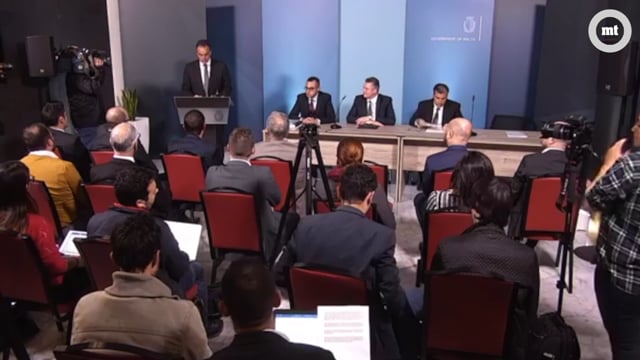Is the interconnector cheaper than gas? Five questions on the NAO’s price comparison
How Enemalta answered to the price comparison by the Auditor General on energy from gas versus the Malta-Italy interconnector

In its evaluation of the prices paid for electricity purchased by Enemalta, the NAO found that interconnector prices were far cheaper than those from the Electrogas power plant.
Interconnector electricity rates between June 2017 and August 2018 came at an average of €61.75/MWh. This contrasts with the €112.39/MWh paid for electricity bought from the Electrogas power plant during the same period.
The price differential was described as a “conservative figure” by the NAO.

READ ALSO:
‘Significant concern’ over due diligence in Electrogas tender – Auditor General
Electrogas report lists 200 million reasons why Konrad Mizzi should go - Adrian Delia
Konrad Mizzi strikes triumphant note, ‘I have no connection to 17 Black or Macbridge’
So how did the NAO carry out its comparison?
The NAO had to establish whether the rate at which Enemalta purchased electricity from Electrogas was more favourable than that procured through the interconnector. Taking the period April 2017 to June 2018, the NAO said Enemalta procured just over 931,000 MWh of electricity from the interconnector for €57.3 million – an average rate of €61.75 per unit (MWh), which includes a €0.20/MWh scheduling fee. An annual service charge of €360,000 and €707,740 in imbalance payments during 2017 were not included.
As for gas, the charges invoiced by Electrogas for the D4 plant were €111.4 million for 1.41 million MWh – or €78.96 per unit. But Enemalta also has to pay an “energy availability fee” that amounts on average to €33.43 per unit – so, D4 gas rates cost on average €50/MWh more than interconnector “when excluding capital costs for the latter”.
Why did Enemalta disagree with this comparison?
As stated by the NAO itself, the comparison does not include the capital costs of the interconnector, that is fixed and variable costs, which make all the difference.
Engineer Jonathan Scerri, who described the comparison as a “totally disappointing and incorrect analysis” said the period under review was a transitory period during which D4 would run on an open cycle and not at full efficiency, as laid down in the contract, and explained why sample prices were “abnormally high and skewed against the Electrogas prices”.
But Scerri took issue with NAO’s exercise for simply dividing the total costs of interconnector energy by total units purchased. In reality these are not actual purchase prices, because Enemalta only bids for interconnector energy at the cheapest price available “like someone who buys only during a sale when prices go down.”
Scerri said that without the Electrogas plant, Enemalta would have to buy “only interconnector energy at all times at the market prices, whatever they are.”
Why did the NAO omit the interconnector’s fixed costs?
Ostensibly, the NAO failed to compare like with like when it compared interconnector prices with the Electrogas prices and adding on the fixed costs of the gas project. Scerri said that on a €300 million project Enemalta incurs at least €10 million in depreciation every year, some €12 million in interest rates from loans Enemalta took out when it had junk ratings, insurance on the plant that is paid by Enemalta, and operational costs when Enemalta has to switch on diesel engines due to faults. Scerri claimed that had fixed costs also been added to the interconnector sample prices, they would rise by 54%, and that does not include transmission losses and other technical losses (oftentimes, a 100 units of energy are reduced to 96 once they arrive to Malta from Sicily). “It’s like renting a car and filling it with €5 fuel: if you get to drive it all day, you cannot say it only cost you €5 and omit the cost of renting the car,” Scerri said.
Can’t Enemalta just buy the ‘cheaper’ interconnector energy?
The NAO said there is room for improvement in terms of when Enemalta decides to buy electricity from the interconnector. Enemalta buys greater volumes when the price increases and less volumes as the price decreases, to varying degrees, in 35 out of the 65 weeks reviewed. The NAO claims a “passive buying strategy”, whereby the total volume purchased by Enemalta over the 15-month period under review was equally distributed across all hours, would have yielded a marginal improvement on Enemalta’s performance. Had Enemalta limited instances of purchase from the interconnector to the hours when the rate was favourable in comparison to that of Delimara 4, maintaining the same total volume, Enemalta would have registered savings in excess of €10 million.
Why can’t Enemalta do this instead?
As Jonathan Scerri explained, you cannot just buy interconnector energy units off some price list: it is bought by an auction and once Enemalta bids for the price, that price can change at the close of trading.
Additionally, the prices for the interconnector energy vary according to the hour they are purchased for. In fact, the price increases at the time Malta mostly needs it: it is at its cheapest at 4-5am, and more expensive at 8-9pm when peak demand hits in Malta. So when Enemalta needs the interconnector energy the most, it has to buy it at the most expensive rates.
Scerri also described the NAO’s ‘constant demand’ exercise as a “purely futile” exercise based on a fictitious scenario. “You cannot forecast the price of interconnector energy,” Scerri said. In the summer of 2018, interconnector prices exploded by 40% hour on hour, and only this week, prices at a certain hour are going for €200/MWh – three times the gas price during low-demand season. “Enemalta recently purchased more gas than it requires in the contract, because it is more worthwhile generating that energy from gas than buying it from the interconnector.”
















.jpg)





